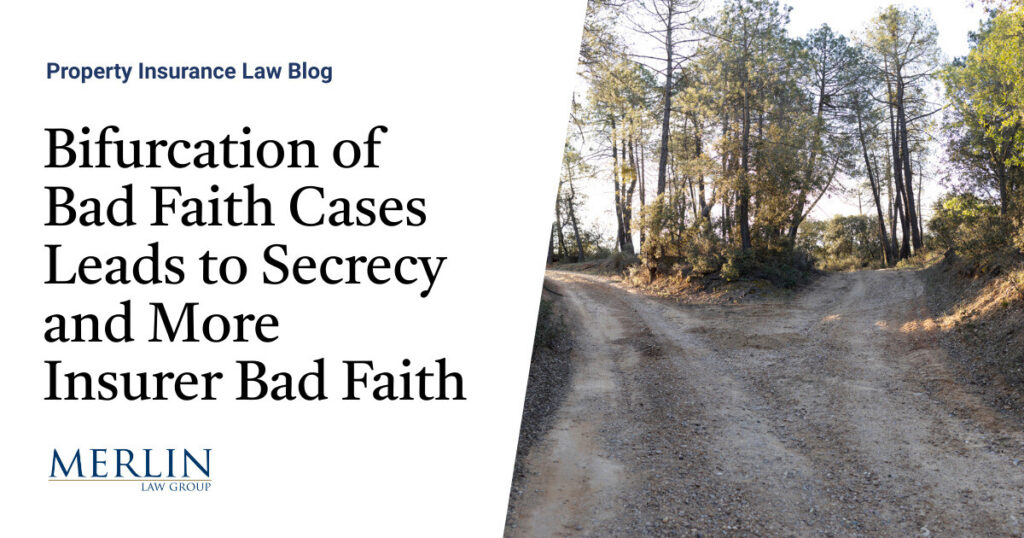Bifurcation of Bad Faith Cases Leads to Secrecy and More Insurer Bad Faith

We do not win all of our cases. But Merlin Law Group attorneys understand that if we agree to accept a case, it means that the attorney and the firm are going to do our best to win. All policyholders should select attorneys with a great resume’ and a history of winning complex and high-dollar cases. Those were my thoughts as I was studying a recent “bifurcation decision” that most would never think of as important but arises in most bad faith cases we discuss in our law firm on a daily basis.
Insurance companies want to delay and avoid any discussion of what they may have done wrong in the adjustment of a case, which leads to a delayed or denied insurance claim. A recent case decision involved a dispute with State Farm Fire and Casualty Company over insurance coverage following a severe hailstorm that damaged the policyholders’ home in Omaha, Nebraska. 1 The crux of the issue was the adequacy and handling of their insurance claim by State Farm. State Farm wanted to delay and “bifurcate” the bad faith case against it until the contract claim was concluded.
The Lawsuit
The policyholders filed a lawsuit against State Farm, claiming:
Breach of contract for not covering the full repair costs.
Bad faith for underestimating the claim, ignoring evidence, delaying responses, and forcing them to sue for coverage.
State Farm denied these claims and filed a motion to bifurcate (separate) the breach of contract and bad faith claims and to stay discovery (information gathering) on the bad faith claim until the breach of contract claim was resolved. They argued that discovery on the bad faith claim would be irrelevant and prejudicial if the breach of contract claim failed.
Court’s Analysis and Decision
The court examined several factors to decide on bifurcation:
Convenience and Judicial Economy: The court found that overlapping evidence in both claims made bifurcation inefficient. Conducting discovery on both claims simultaneously would avoid duplicative efforts and potential delays.
Prejudice: State Farm argued that discovery on the bad faith claim could prejudice the jury. However, the court noted that the same evidence might be relevant to both claims, making it practical to handle them together.
Settlement Potential: Joint discovery could facilitate settlement discussions by providing a complete picture of both claims to both parties.
Bifurcation is not accepted practice, and the insurance company should prove that it is needed before a court agrees to this procedure. My view is that insurance companies often want to gain negotiating leverage by delaying the full discussion of why the claim was denied, the disclosure of the evidence, which is often hidden about the bad faith agenda to pay less than what is owed and profit from the delay, and otherwise gain a tactical advantage about negotiating a full settlement with an ignorant plaintiff who has been denied discovery of facts which add significant value to the claims.
The key rulings by the court were as follows:
Denial of Motion to Bifurcate: The court denied State Farm’s motion to bifurcate the breach of contract claim from the bad faith claim. State Farm had argued that the two claims should be separated and discovery on the bad faith claim should be stayed until the breach of contract claim was resolved. The court found that the claims were interconnected and that evidence relevant to one claim might also be relevant to the other. Thus, separating them would be inefficient and could lead to duplicative efforts and delays.
Denial of Motion to Stay Discovery on Bad Faith Claim: Alongside denying bifurcation, the court also denied the motion to stay discovery on the bad faith claim. The court reasoned that discovery on both claims simultaneously would promote judicial economy and efficiency. It would also ensure that both parties had all the necessary information for a fair evaluation of their positions, which could facilitate settlement discussions.
Factors Considered: In making its decision, the court considered several factors, including:
o The convenience and judicial economy of handling both claims together.
o The potential prejudice to State Farm if the claims were not bifurcated.
o The overlap of evidence between the breach of contract and bad faith claims.
o The impact on settlement potential if discovery on both claims was conducted jointly.
This case decision, which will probably be overlooked by many because it is a “nerdy” procedural decision, impacts policyholders. Policyholders should have the right to know the bias and reasons why insurance companies hire outcome-oriented vendors and fail to fully investigate claims in good faith. It does not take a rocket scientist to figure out that when giving incentives to underpay claims through various means, the insurance companies and their attorneys do not want to disclose those and try to keep them hidden from the light of day.
The truth will set you free. However, insurance companies and their attorneys who argue for secrecy have no financial incentive to live by that credo. This recent case decision is a step in the right direction. People and insurance companies doing wrong will not do so if their secrets are exposed and they are made accountable for their wrongdoings.
Two Thoughts For The Day
If corruption is a disease, transparency is a central part of its treatment.
— Kofi Anann
Honesty and transparency make you vulnerable. Be honest and transparent anyway.
— Mother Teresa
1 Siedlik v. State Farm Fire & Cas. Co., No. 8:24-cv-00027 (D. Neb. 2024).







